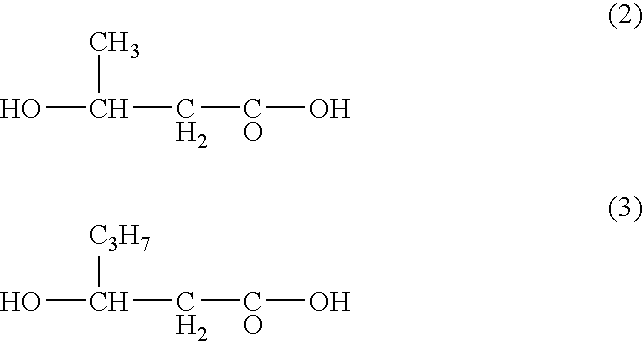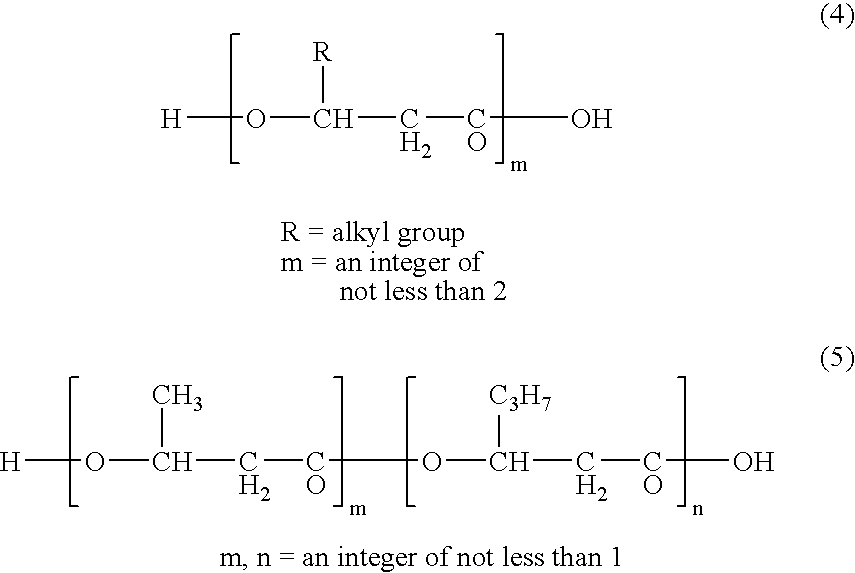Transformant and process for producing polyester by using the same
- Summary
- Abstract
- Description
- Claims
- Application Information
AI Technical Summary
Benefits of technology
Problems solved by technology
Method used
Image
Examples
example 1
Polyester Synthesis-Associated Genes
[0088] (a) When Yarrowia lipolytica was Used as the Host
[0089] As polyester synthesis-associated enzyme gene, the PHA synthase gene (phac; SEQ ID NO:1) derived from Aeromonas caviae and (R)-specific enoyl-CoA hydratase gene (phaJ; SEQ ID NO:2) which converts enoyl-CoA, an intermediate in the .beta.-oxidation pathway, to the monomeric (R)-3-hydroxyacyl-CoA [T. Fukui et al., FEMS Microbiology Letters, Vol. 170, 69-75 (1999)] were used.
[0090] (b) When Candida maltosa was Used as the Host
[0091] As polyester synthesis-associated enzyme gene, this gene was constructed with reference to the amino acid sequences of Aeromonas caviae-derived PHA synthase and (R)-specific enoyl-CoA hydratase which converts enoyl-CoA, an intermediate in the .beta.-oxidation pathway, to the monomeric (R)-3-hydroxyacyl-CoA [T. Fukui et al., FEMS Microbiology Letters, Vol. 170, 69-75 (1999)].
[0092] Candida maltosa is a yeast which translates the CTG codon toserine, not to leucin...
example 2
Construction of a Recombinant Plasmid and a Recombinant Strain
[0094] (a) When Yarrowia lipolytica was Used as the Host
[0095] In order that the above genes may be expressed in Yarrowia lipolytica, the Yarrowia lipolytica AlK3 gene promoter ALK3p (SEQ ID NO:5) (GenBank AB010390) was ligated upstream of the 5' end of each gene. The restriction enzyme sites necessary for linking the promoter to the structural gene were prepared by PCR. The primer sequences used in PCR are shown in SEQ ID NO:8 through NO:14. PCR was carried out in 25 cycles of 94.degree. C..times.1 min., 55.degree. C..times.2 min., 72.degree. C..times.3 min. for amplification of the particular gene fragment. The polymerase used was Takara Shuzo's ExTaq. Regarding the promoter region, ALK3X with XbaI at 5'-end and NdeI at 3'-end and ALK3S with SacII at 5'-end and NdeI at 3'-end were prepared from SEQ ID NO:8 and SEQ ID NO:9 or SEQ ID NO:9 and SEQ ID NO:10 respectively, using SEQ ID NO:5 as a template.
[0096] As regards pha...
example 3
Productioon of P(3HB-co-3HH) Using a Recombinant Strain of Yarrowia lipolytica
[0105] The recombinant strains of Yarrowia lipolytica containing the plasmids pSUT5, pSUT-PHA1 and pSUT-PHA2 were cultured in the following manner. As the preculture medium, YPD medium (1 w / v % yeast-extract, 2 w / v % Bacto-Pepton, 2 w / v % glucose) was used. As the polyester production medium, 1 / 4 YP medium (0.25 w / v % yeast extract, 0.5 w / v % Bacto-Pepton) and a mineral medium (0.7 w / v % KH.sub.2PO.sub.4, 1.3 w / v % (NH.sub.4).sub.2HPO.sub.4, 0.5 w / v % Pro-Ex AP-12 (Banshu Condiment), 0.04 w / v % adenine, 1 ppm thiamine hydrochloride, 1 v / v % trace metal salt solution (as dissolved in 0.1 N--HCl, 8 w / v % MgSO.sub.4.7H.sub.2O, 0.6 w / v % ZnSO.sub.4.7H.sub.2O, 0.9 w / v % FeSO.sub.4.7H.sub.2O, 0.05 w / v % CuSO.sub.4.5H.sub.2O, 0.1 w / v % MnSO.sub.4.6-7H.sub.2O, 1 w / v % NaCl)) supplemented with 2 w / v % palm oil was used.
[0106] A 500-ml Sakaguchi flask containing 100 ml of the preculture medium was inoculated with 10...
PUM
| Property | Measurement | Unit |
|---|---|---|
| Length | aaaaa | aaaaa |
| Gene expression profile | aaaaa | aaaaa |
Abstract
Description
Claims
Application Information
 Login to View More
Login to View More - Generate Ideas
- Intellectual Property
- Life Sciences
- Materials
- Tech Scout
- Unparalleled Data Quality
- Higher Quality Content
- 60% Fewer Hallucinations
Browse by: Latest US Patents, China's latest patents, Technical Efficacy Thesaurus, Application Domain, Technology Topic, Popular Technical Reports.
© 2025 PatSnap. All rights reserved.Legal|Privacy policy|Modern Slavery Act Transparency Statement|Sitemap|About US| Contact US: help@patsnap.com



